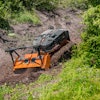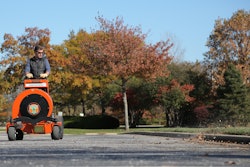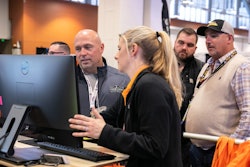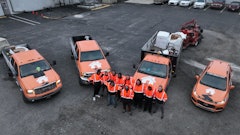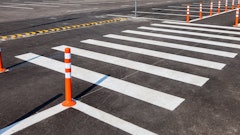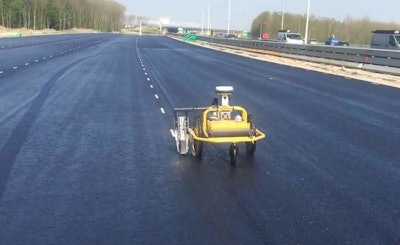
As contractors prepare for work on the more than 173,000 miles of United States roads that are in poor repair and as private work from parking lot construction and maintenance holds firm even as labor is in short supply, technology capable of streamlining pavement striping and marking will become even more attractive.
Striping of roadways requires not just the high-temperature application of thermoplastic, but a pre-lining process commonly completed by a surveying team charged with identifying the exact position of lane markers, generally using a total station. Automated solutions are coming to market, including the TiyMobileRobot product line for roadways and parking lot pre-lining and turf line marking. These automation tools use either cell connectivity or an on-board GNSS device to orient the robot geographically as it sprays a paint line that delineates the precise position for permanent marking.
The TinySurveyor and TinyPreMarker robots integrate with global navigation satellite system (GNSS) receivers from major manufacturers including Topcon, Trimble and Leica. The TinySurveyor, unlike the TinyPremarker is not sold with its own GNSS receiver, and integrates with external total stations for positioning data including height measurements. A prism mounted beneath the TinySurveyor’s GNSS antennae enables accuracy tolerances of less than one inch. The robots mark points with a standard aerosol can, making fast work of road center lines or layout of sites like solar parks. Using two points for a line or three points for an arc, the robots have application pre-marking lines on roadways and survey site staking.
The robots are only one component in an overall solution that also includes a tablet and cloud application that controls and can lock the robot. The cloud application also enables TinyMobileRobots to access and troubleshoot robots for their customers, and the tablet controller can be used to manually operate the robots through a Bluetooth connection. The robots do their own edge computing work to automate their precise positioning capabilities—critical in applications where they may not be able to access a cellular network. This heavy lifting is handled by the Robot Operating System (ROS) framework, which gives software access to hardware resources, provides the drivers required to run hardware and enables multiple processes to coordinate across the different pieces of hardware and components that comprise a robot. GNSS location and layouts downloaded from the cloud or installed through a USB port give the robots the information they need to navigate.
Parking Lot Problems
Beyond roadways, the robots have applications in parking lots as well as in indoor line marking applications, according to TinyMobileRobots CEO Jens Peder Kristensen. Parking lots, however, present special challenges for automation.
“In parking lots, the major challenge for pre-marking/laying out is that GPS accuracy is reduced by trees and buildings,” Kristensen said. “Working with an accuracy below one-half inch is very demanding for the GPS technology and requires that there is a certain distance to buildings and trees. The problem stems from multipath. Signals from GPS are reflected by houses and trees, and the reflection can reduce accuracy significantly.”
Other challenges stem from a lack of accuracy of curb placements in parking lots, which then conflict with the geolocation data the robot uses to orient.
“Before the layout can be done, the landscape contractors install the curbs and the small trees for the area,” Kristensen said. “In this case, the trees are so small it does not matter, but the curbs matter. And the landscape contractor does not care so much about half-inch accuracy. This makes the use of the CAD drawing for the robot pre-marking/layout difficult, because the high efficiency of the robot is only achieved if you have correct CAD drawings that reflect actual location of the curb.”
Contractors accepting projects to mark pavement indoors, for safety lines in large warehouse or production facilities or in a construction environment to mark wall locations, can also leverage this technology. Apart from pre-marking for lines to be painted later, the robots can be used to mark height curves in support of floor leveling processes. But again, the use case requires changes to the hardware.
“In the Indoor cases, the GPS will not work, so customers typically use a robotic total station,” Kristensen said. “The robotic name of the robotic total station comes from the fact that it automatically follows the robot around and thereby automizes the work of a person. The combination of the robot and the robotic total station allows for very accurate indoor layouting.”
All In One Process
TinyMobileRobots has a separate product line that marks parking and sports field lines on turf grass, but has not pursued line painting on pavement. Kristensen points out the issues are different in parking lots versus public roadways.
“Final marking with the robot has two challenges,” Kristensen said. “One is the problem with trees and buildings. If the premarking/layout is disturbed by trees and houses, you can easily see it with your eyes and you can correct it before the final marking. Furthermore, the paint used for final marking is often thermoplastic that needs to be heated to 400 F. This cannot be done with a small robot.”
Despite these challenges, work is progressing towards an automated approach to final line marking. RoadPrintz Inc. and Case Western Reserve University have collaborated on a prototype pavement marking vehicle to demonstrate that the technology can stripe cheaper, faster and with significantly less risk to road-workers.
For parking lots, an Estonian company has developed an automated line marking robot last year nailed down $775,000 to help develop its line of parking lot and road marketing robots. 10Lines claims on its web site the robots stripe parking lots seven times faster than other means with no premarking. The company has not yet announced availability or distribution in the United States.



